#Roosevelt Roberts
Text
youtube
Hooked On Your Love - Roosevelt Roberts (I Bet You I Win / Hooked On Your Love, 197?)
#Soul#Soul Music#Soul Music Songs#Music#Music Songs#Roosevelt Roberts#Hooked On Your Love#R & R#197?#Youtube
4 notes
·
View notes
Text
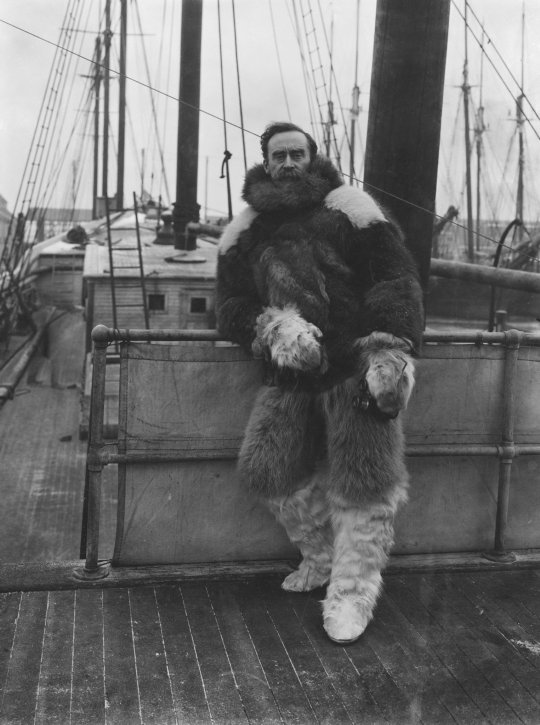
218 notes
·
View notes
Text
I'M AMERICAN. AMERIKANSKI. ROOSEVELT. STALIN. COCA-COLA.
#rosie rosenthal#robert rosenthal#masters of the air#mota#hbo war#IM AMERICAN AMERIKANSKI ROOSEVELT STALIN COCA COLA
91 notes
·
View notes
Text

Les couleurs de la ville.
Mur
#photographie urbaine#urban photography#couleurs urbaines#urban colors#décor urbain#urban decor#abstraction#figuration#mur#wall#minimalisme#minimalism#rue robert#saxe roosevelt#69006#lyon#rhône#auvergne rhône alpes#france#photographers on tumblr#poltredlyon#osezlesgaleries#monlyon#onlylyon#igerslyon#lyonurb
102 notes
·
View notes
Text
Out Representative-elect Robert Garcia (D-CA) may not have been able to get sworn in yesterday due to Republicans’ inability to elect a Speaker of the House, but he has plans for when he finally can be sworn in.
When he takes his oath of office, he’ll swear on a copy of the Constitution, and, beneath that, an original Superman #1 comic from 1939, a photo of his parents, and a copy of his citizenship certificate.

Garcia came to the U.S. from Peru with his family when he was five-years-old and has said that naturalization was “his proudest moment” and the reason he started a career in politics. His parents died in 2020 of COVID-19.
He was the youngest and first out LGBTQ+ person elected as mayor of Long Beach, California (a position he served in from 2014 to 2022). During his time as mayor, he worked with businesses to reduce their environmental impacts, filled vacancies on citizen commissions with diverse and female members, and worked to improve local infrastructure as well as financial opportunities for local artists and home-based business owners.
He’s also an avid comic book fan.
In November, he tweeted a photo of the Superman #1 comic along with Amazing Fantasy #15, in which Spider-Man first appeared, saying he didn’t know which one he would first check out from the Library of Congress.
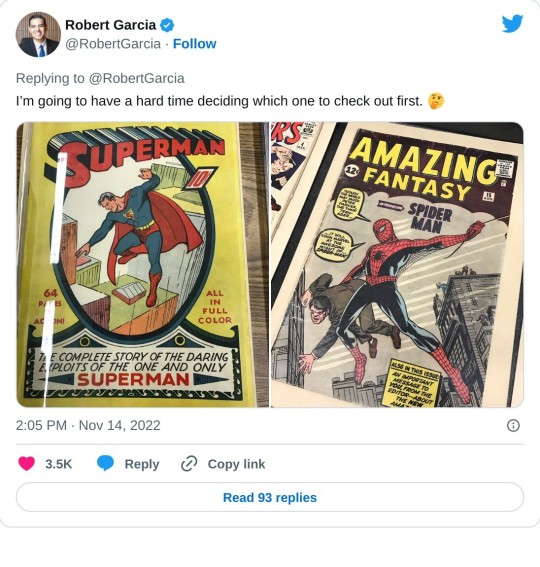
While many members of Congress will be sworn in on Bibles, they are not legally required to do so. Former Rep. – and current Minnesota attorney general – Keith Ellison (D-MN), who was the first Muslim person elected to Congress in 2007, was sworn in on a copy of the Quran owned by Thomas Jefferson.
Theodore Roosevelt wasn’t sworn in with any object after the assassination of William McKinley in 1901. And in 2014 Suzi LeVine was sworn in as U.S. ambassador to Switzerland and Liechtenstein on a Kindle with a copy of the Constitution open.
“I wanted to use a copy that is from the twenty-first century and that reflects my passion for technology and my hope for the future,” she said at the time.
New members of the House can’t be sworn in until a speaker is elected. Yesterday, after three votes, no candidate for Speaker was able to get a majority of votes because of a faction of Republicans voting against Rep. Kevin McCarthy (R-CA). The Democrats’ candidate – Rep. Hakeem Jeffries (D-NY) – got the most votes in each round of voting, and around 20 Republicans – including anti-LGBTQ+ Reps. Paul Gosar (R-AZ), Lauren Boebert (R-CO), Bob Good (R-VA), and Matt Gaetz (R-FL) – voted for Rep. Jim Jordan (R-OH).
Jordan himself nominated and voted for McCarthy.
The House adjourned without a new Speaker elected.
#us politics#news#2023#twitter#tweet#Democrats#lgbtq nation#robert garcia#us house of representatives#118th congress#detective comics#us constitution#library of congress#lgbtqia+#lgbtqia+ representation#lgbtqia+ pride#us history#President Theodore Roosevelt#Suzi LeVine#Keith Ellison#superman#California
512 notes
·
View notes
Note
Was Trump's assassination attempt the first time people other than the president were also killed or hurt?
No, it definitely was not the first time. There have been a number of additional victims during Presidential assassinations or assassination attempts throughout American history.
Here are the incidents where someone other than the President was wounded in an assassination attempt on Presidents or Presidential candidates:
•April 14, 1865, Washington, D.C.
At the same time that John Wilkes Booth was shooting Abraham Lincoln at Ford's Theatre, Booth's fellow conspirator, Lewis Powell, attacked Secretary of State William H. Seward at Seward's home in Washington. Seward had been injured earlier that month in a carriage accident and was bedridden from his injuries, and Powell viciously stabbed the Secretary of State after forcing his way into Seward's home by pretending to deliver medicine. Powell also attacked two of Seward's sons, a male nurse from the Army who was helping to care for Seward, and a messenger from the State Department. Another Booth conspirator, George Azterodt, was supposed to kill Vice President Andrew Johnson at the same time that Lincoln and Seward were being attacked in an attempt to decapitate the senior leadership of the Union government, but Azterodt lost his nerve and got drunk instead. A total of five people were wounded at the Seward home as part of the Booth conspiracy, but Lincoln was the only person who was killed.
•February 15, 1933, Miami, Florida
Just 17 days before his first inauguration, President-elect Franklin D. Roosevelt was the target of an assassination attempt in Miami's Bayfront Park. Giuseppe Zangara fired five shots at Roosevelt as FDR was speaking from an open car. Roosevelt was not injured, but all five bullets hit people in the crowd, including Chicago Mayor Anton Cermak who was in the car with FDR. Roosevelt may have been saved by a woman in the crowd who hit Zangara's arm with her purse as she noticed he was aiming his gun at the President-elect and caused him to shoot wildly. Mayor Cermak was gravely wounded and immediately rushed to a Miami hospital where he died about two weeks later.
•November 1, 1950, Blair House, Washington, D.C.
From 1949-1952, the White House was being extensively renovated with the interior being almost completely gutted and reconstructed. President Harry S. Truman and his family moved into Blair House, a Presidential guest house across the street from the White House that is normally used for visiting VIPs, for 3 1/2 years. On November 1, 1950 two Puerto Rican nationalists, Griselio Torresola and Oscar Collazo, tried to shoot their way into Blair House and attempt to kill President Truman, who was upstairs (reportedly napping) at the time. A wild shootout ensued on Pennsylvania Avenue, leaving White House Police Officer Leslie Coffelt and Torresola dead, and Collazo and two other White House Police Officers wounded.
•November 22, 1963, Dallas, Texas
Texas Governor John Connally was severely wounded after being shot while riding in the open limousine with President John F. Kennedy when JFK was assassinated.
•June 5, 1968, Ambassador Hotel, Los Angeles, California
When he finished delivering a victory speech after winning California's Democratic Presidential primary, Senator Robert F. Kennedy of New York was shot several times while walking through the kitchen of the Ambassador Hotel. While RFK was mortally wounded and would die a little over a day later, five other people were also wounded in the shooting.
•May 15, 1972, Laurel, Maryland
Segregationist Alabama Governor George Wallace was paralyzed from the waist down after being shot by Arthur Bremer at a campaign rally when he was running for the Democratic Presidential nomination. Three bystanders were also wounded in the shooting, but survived.
•September 22, 1975, San Francisco, California
A taxi driver in San Francisco was wounded when Sara Jane Moore attempted to shoot President Gerald Ford as he left the St. Francis Hotel. Moore's first shot missed the President by several inches and the second shot, which hit the taxi driver, was altered when a Vietnam veteran in the crowd named Oliver Sipple grabbed her arm as she was firing. Just 17 days earlier and 90 miles away, Lynette "Squeaky" Fromme, a member of the Charles Manson family, had tried to shoot President Ford as he walked through Capitol Park in Sacramento but nobody was injured.
•March 30, 1981, Washington, D.C.
President Ronald Reagan was shot and seriously wounded by as he left the Washington Hilton after giving a speech. Three other people were wounded in the shooting, including White House Press Secretary James Brady who was shot in the head and partially paralyzed, Washington D.C. Police Office Thomas Delahanty, and Secret Service agent Tim McCarthy. Video of the assassination attempt shows that when the shots were fired, McCarthy turned and made himself a bigger target in order to shield the President with his own body. President Reagan was struck by a bullet that ricocheted off of the Presidential limousine.
#History#Presidential Assassinations#Presidential Assassination Attempts#Presidency#Politics#Political History#Assassinations#Attempted Assassinations#Lincoln Assassination#Assassination of Abraham Lincoln#Booth Conspiracy#Attempted Assassination of President-elect Franklin D. Roosevelt#FDR#Franklin D. Roosevelt#President Roosevelt#Puerto Rican Nationalists#Attempted Assassination of Harry S. Truman#President Truman#Secret Service#United States Secret Service#White House Police#Presidential History#Robert F. Kennedy#RFK Assassination#Assassination of Robert F. Kennedy#Attempted Assassination of George Wallace#Attempted Assassination of Gerald Ford#President Ford#Attempted Assassination of Ronald Reagan#President Reagan
23 notes
·
View notes
Text

I see a United States which can demonstrate that, under democratic methods of government, national wealth can be translated into a spreading volume of human comforts hitherto unknown…But here is the challenge to our democracy: In this nation I see tens of millions of its citizens…who at this very moment are denied the greater part of what the very lowest standards of today call the necessities of life…The test of our progress is not whether we add more to the abundance of those who have much; it is whether we provide enough for those who have too little.
—Franklin D. Roosevelt, Second Inaugural Address, Washington, DC, Jan 20, 1937
(Robert Scott Horton)
15 notes
·
View notes
Text
FILM STILLS: THE MAIN CAST OF THE ALIENIST
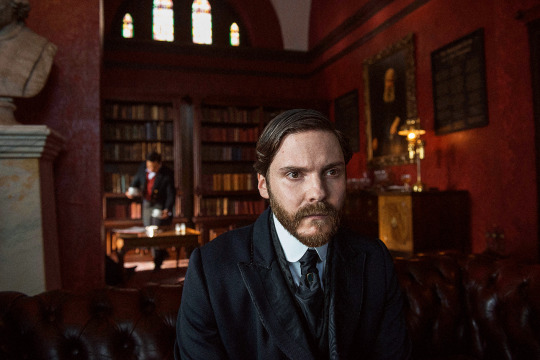
Daniel Brühl as Dr. Laszlo Kreizler

Dakota Fanning as Sara Howard

Luke Evans as John Schuyler Moore

Q'orianka Kilcher as Mary Palmer
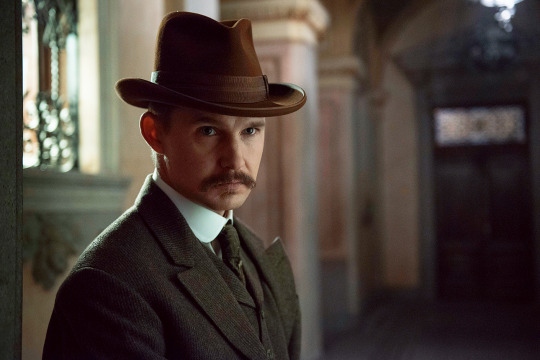
Brian Geraghty as Theodore Roosevelt

Douglas Smith as Marcus Isaacson

Matthew Shear as Lucius Isaacson
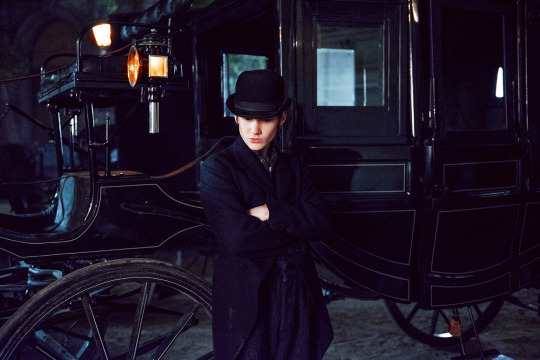
Matt Lintz as Stevie Taggert
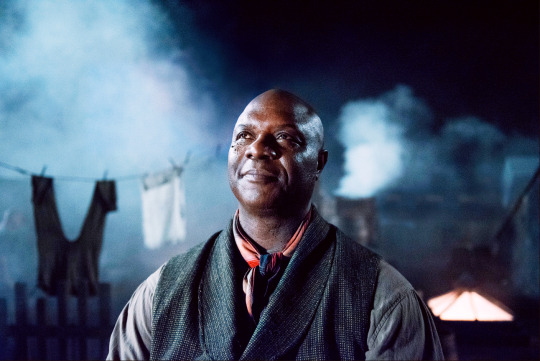
Robert Ray Wisdom as Cyrus Montrose
#the alienist#cast#photos#film stills#daniel brühl#laszlo kreizler#sara howard#dakota fanning#john moore#luke evans#Q'orianka Kilcher#Mary Palmer#Brian Geraghty#Theodore Roosevelt#Cyrus Montrose#Robert Ray Wisdom#Douglas Smith#Marcus Isaacson#Matthew Shear#Lucius Isaacson#Matt Lintz#Stevie Taggert#caleb carr#tv show#my edits
19 notes
·
View notes
Text
Hotel Berlin (1945)
This might be the most underrated War Era movie I've seen yet.
Both the theatrical trailer and the DVD cover advertise it as a corny exploitation movie. It's nothing of the sort. It's as sincerely written and acted as "Casablanca," with far more direct references to the Jewish people, and specific concentration camps.
I legitimately ordered the DVD just to see Peter Lorre as a disheveled angst-ridden scruff-muffin; I had no idea the character was going to be so compelling, or the rest of the movie equally so. Several other characters also exploded beyond the old clichés I was expecting. The movie appears to be building towards a predictable, cheesy love story, but...doesn't. Another character who at first appears one of the most despicable opportunists in the movie...isn't. And the movie's nuanced look at an indoctrinated population being carpet-bombed while their tyrannical, antisemetic leaders flee to save their own skins is uh...timely, to say the least.
I'm sure it helped that I watched this movie during a rainstorm at night, which is the way to watch it. The timeliness of a story about
Spoilers Below!
Faye Emerson deserved that top billing.

According to IMDB, Andrea King was originally to be billed as the film's female lead, with Faye Emerson billed as a supporting character. When Emerson married the son of President Roosevelt, she was given top billing over King, to capitalize on her new fame. I find that ironic, given that by the end of the movie, Faye's character Tilly has, against all odds, proven to be the film's true heroine.
Introduced as a materialistic Nazi informer, dating SS officers and betraying a hiding resistance fighter just to get herself some new shoes, Tilly's reality turns upside-down when she learns that the lover she thought she'd lost is still alive. After an emotional breakdown over what her despair let her become, she defends her boyfriend's mother against a Nazi officer, and delivers the most powerful speech in the movie. It is her character who finally mentions the Jews out loud, after an entire movie and an entire genre dancing around the subject.
I've recorded the scene from the DVD and uploaded it to YouTube:
youtube
"Go on shoot me, arrest me, have me killed, I don't care! Why should I. I loved Max Baruch and you sent him to a concentration camp! You hung a sign around my neck saying I loved a Jew! And you paraded me down the street. They'll hang something around your neck someday, and it won't be a sign!"
Corny Romance is Just a Red Herring

My stance that Emersen deserved that top billing in no way negates Andrea King's marvelous performance as the film's faux female lead. Though we are warned right from the start that her character, movie star Lisa Dorn, is a Nazi and a master manipulator, the film plays her as the straightforward love interest for much of the film: helping the hero partially out of the hope that he'll save her in return, seemingly building a genuine admiration for his heroism...then completely subverts expectations by revealing her to be exactly what she she was introduced as: a Nazi collaborator out to save her own skin.
I was genuinely afraid at the end that the hero would find himself unable to shoot her, and we'd see her tearfully declare her love for him, and end with him forgiving her. Not so. She argues pathetically, trying to excuse her betrayal and convince Richter that she loves him, and he doesn't fall for it. Richter sees Sam Spade's "I'll be waiting for you," and raises him two gunshots.
Peter Lorre like we've never seen him before

Okay, maybe we have seen Peter angsting around and wobbling drunkenly a few times before. But this was the first time I saw him directly address the issues that so closely affected him (and his costars of course) in real life.
Peter Lorre died before talk about the Holocaust really became mainstream. But the emotion behind the lines he delivers as the self-hating German professor speaks volumes. The gleeful smile he wears in his first scene, while saying that the bombing is only what the Germans deserve; his bitter sarcasm about the achievements of German science in the concentration camps, and wondering where all the "good Germans" are now; his breakdown when Richter tells him of a mutual friend's murder at Dachau. Much like his frantic escape attempt in "Casablanca," Peter likely didn't have to fish too hard to dig up the needed emotions for these scenes.
This is also the closest I've ever come to seeing Peter cry.


Other PL fans have lamented that his role was too small. I agree that I'd have loved to see a hell of a lot more of Koenig, but it's not like many of the other characters had much more screen time, which all the different storylines running at once. Aside from maybe Helmut Dantine and Andrea King, most of the important characters probably only have a handful of scenes tops.
Edit: That said, knowing he had scenes indicating how he joined the resistance that were cut is very frustrating.
But the fact that Peter's character not only lives to the end as one of the heroes, but gets to read President Roosevelt's uplifting speech to the German people, definitely counts for something.

That speech packed a powerful punch for me, at a time when I sometimes need reminding that indoctrinated civilians in war zones are still individuals, and can't be lumped with their dogmatic leaders. I don't doubt for a minute that President Biden took inspiration from Roosevelt for how to address the Palestinian people in regards to stopping Hamas.
The Fugitive

I suppose I should also mention the film's lead: Helmut Dantine as Martin Richter, the German anti-Nazi resistance fighter who escaped Dachau Concentration Camp. Helmut Dantine played Jan, the Bulgarian husband in "Casablanca." The controlled desperation with which he gambled at Rick's roulette wheel as Jan serves well for his fugitive resistance fighter in this movie. The fact that Dantine was actually imprisoned at Rosserlaende Concentration Camp for his anti-Nazi political activism at age 19 no doubt also helped him in the role.
My only complaint is the makeup and costuming department failing to help him look the part. While Paul Henreid got a scar and a white streak of hair for Victor Laszlo, Dantine is done up to look like a particularly slick, clean movie star, standing out in a cast of disheveled and weary looking people. One could interpret this as a symbolic way of singling him out as the hero, but I found it distracting. I am not throwing shade on Dantine's acting abilities or natural looks, just how the people in charge had him presented.
I'm unsure how to close this review.
It's getting late and I have some more clips to upload, and cake to eat. "Hotel Berlin" is up there with "Casablanca" on my personal list of unironically great old movies. Professor Koenig is on my list favorite Peter Lorre characters, and I have a handful of new favorite actors.
I'll just finish by saying that this guy in the barrette looks noticeably like Robert Picardo, if maybe a "stretched out" version thereof. Voyager's EMH hanging out with a holo-Peter Lorre in one of Tom Paris's noir programs is something I never knew I needed.

#hotel berlin#hotel berlin 1945#peter lorre#review#faye emerson#helmut dantine#1940s#wwii#germany#gaza#nazi#fdr#franklin d. roosevelt#andrea king#tilly#professor johannes koenig#scruffy#sad#holocaust#jewish#antisemitism#noir#classic movies#jan brandel#casablanca#screencaps#star trek voyager#emh#robert picardo#holodeck
11 notes
·
View notes
Text
spent an hour being called out by my history teacher who kept looking up old dead men asking me if i find them attractive (yes i did) because his wife (my cadet teacher) TOLD HIM I LIKED OLD DEAD UGLY MEN!!! THIS WAS TOLD IN CONFIDENCE IM EMBARASSED…



anyways he found out my type immediately. aren’t they so hot though
#me#do i even tag this#ronald reagan#franklin d roosevelt#robert f kennedy#they’re not even ugly everyone around me is just crazy#this guy hasn’t ever been my history teacher btw i just hang out so much w the history department i’ve just befriended everyone
13 notes
·
View notes
Text
Why Robert Oppenheimer's Atomic Bomb Still Haunts Us
— By Richard Rhodes | Published May 15, 2013
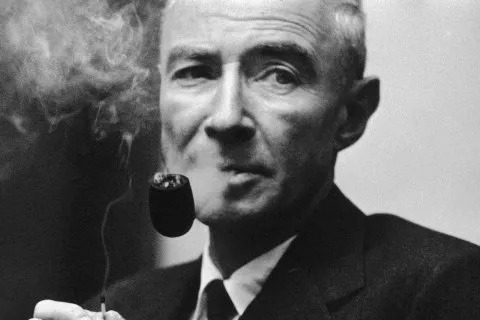
Oppenheimer spearheaded the creation of the atom bomb. René Burri/Magnum
Robert Oppenheimer oversaw the design and construction of the first atomic bombs. The American theoretical physicist wasn't the only one involved—more than 130,000 people contributed their skills to the World War II Manhattan Project, from construction workers to explosives experts to Soviet spies—but his name survives uniquely in popular memory as the names of the other participants fade. British philosopher Ray Monk's lengthy new biography of the man is only the most recent of several to appear, and Oppenheimer wins significant assessment in every history of the Manhattan Project, including my own. Why this one man should have come to stand for the whole huge business, then, is the essential question any biographer must answer.
It's not as if the bomb program were bereft of men of distinction. Gen. Leslie Groves built the Pentagon and thousands of other U.S. military installations before leading the entire Manhattan Project to success in record time. Hans Bethe discovered the sequence of thermonuclear reactions that fire the stars. Leo Szilard and Enrico Fermi invented the nuclear reactor. John von Neumann conceived the stored-program digital computer. Edward Teller and Stanislaw Ulam co-invented the hydrogen bomb. Luis Alvarez devised a whole new technology for detonating explosives to make the Fat Man bomb work, and later, with his son, Walter, proved that an Earth-impacting asteroid killed off the dinosaurs. The list goes on. What was so special about Oppenheimer?
He was brilliant, rich, handsome, charismatic. Women adored him. As a young professor at Berkeley and Caltech in the 1930s, he broke the European monopoly on theoretical physics, contributing significantly to making America a physics powerhouse that continues to win a freight of Nobel Prizes. Despite never having directed any organization before, he led the Los Alamos bomb laboratory with such skill that even his worst enemy, Edward Teller, told me once that Oppenheimer was the best lab director he'd ever known. After the war he led the group of scientists who guided American nuclear policy, the General Advisory Committee to the U.S. Atomic Energy Commission (AEC). He finished out his life as director of the prestigious Institute for Advanced Study in Princeton, New Jersey, where he welcomed young scientists and scholars into that traditionally aloof club.

August 9, 1945: Nagasaki is hit by an atom bomb. Nagasaki Atomic Bomb Museum/EPA
Those were exceptional achievements, but they don't by themselves explain his unique place in nuclear history. For that, add in the dark side. His brilliance came with a casual cruelty, born certainly of insecurity, which lashed out with invective against anyone who said anything he considered stupid; even the brilliant Bethe wasn't exempt. His relationships with the significant women in his life were destructive: his first deep love, Jean Tatlock, the daughter of a Berkeley professor, was a suicide; his wife, Kitty, a lifelong alcoholic. His daughter committed suicide; his son continues to live an isolated life.
His Choices or Mistakes, Combined with his Penchant for Humiliating Lesser Men, Eventually Destroyed Him.
Oppenheimer's achievements as a theoretical physicist never reached the level his brilliance seemed to promise; the reason, his student and later Nobel laureate Julian Schwinger judged, was that he "very much insisted on displaying that he was on top of everything"—a polite way of saying Oppenheimer was glib. The physicist Isidor Rabi, a Nobel laureate colleague whom Oppenheimer deeply respected, thought he attributed too much mystery to the workings of nature. Monk notes his curiously uncritical respect for the received wisdom of his field.
Monk's discussion of Oppenheimer's work in physics is one of his book's great contributions to the saga, an area of the man's life that previous biographies have neglected. In the late 1920s Oppenheimer first worked out the physics of what came to be called black holes, those collapsing giant stars that pull even light in behind them as they shrink to solar-system or even planetary size. Some have speculated Oppenheimer might have won a Nobel for that work had he lived to see the first black hole identified in 1971.
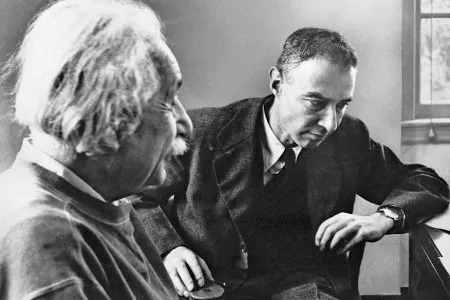
Oppenheimer with Albert Einstein, circa the 1940s. Corbis
Oppenheimer's patriotism should have been evident to even the most obtuse government critic. He gave up his beloved physics, after all, not to mention any vestige of personal privacy, to help make his country invulnerable with atomic bombs. Yet he risked his work and reputation by dabbling in left-wing and communist politics before the war and lying to security officers during the war about a solicitation to espionage he received. His choices or mistakes, combined with his penchant for humiliating lesser men, eventually destroyed him.
One of those lesser men, a vicious piece of work named Lewis Strauss, a former shoe salesman turned Wall Street financier and physicist manqué, was the vehicle of Oppenheimer's destruction. When President Eisenhower appointed Strauss to the chairmanship of the AEC in the summer of 1953, Strauss pieced together a case against Oppenheimer. He was still splenetic from an extended Oppenheimer drubbing delivered during a congressional hearing all the way back in 1948, and he believed the physicist was a Soviet spy.
Strauss proceeded to revoke Oppenheimer's security clearance, effectively shutting him out of government. Oppenheimer could have accepted his fate and returned to an academic life filled with honors; he was due to be dropped as an AEC consultant anyway. He chose instead to fight the charges. Strauss found a brutal prosecuting attorney to question the scientist, bugged his communications with his attorney, and stalled giving the attorney the clearances he needed to vet the charges. The transcript of the hearing In the Matter of J. Robert Oppenheimer is one of the great, dark documents of the early atomic age, almost Shakespearean in its craven parade of hostile witnesses through the government star chamber, with the victim himself, catatonic with shame, sunken on a couch incessantly smoking the cigarettes that would kill him with throat cancer at 63 in 1967.
Rabi was one of the few witnesses who stood up for his friend, finally challenging the hearing board in exasperation, "We have an A-bomb and a whole series of it [because of Oppenheimer's work], and what more do you want, mermaids?" What Strauss and others, particularly Edward Teller, wanted was Oppenheimer's head on a platter, and they got it. The public humiliation, which he called "my train wreck," destroyed him. Those who knew him best have told me sadly that he was never the same again.
For Monk as for Rabi, Oppenheimer's central problem was his hollow core, his false sense of self, which Rabi with characteristic wit framed as an inability to decide whether he wanted to be president of the Knights of Columbus or B'nai B'rith. The German Jews who were Oppenheimer's 19th-century forebears had worked hard at assimilation—that is, at denying their religious heritage. Oppenheimer's parents submerged that heritage further in New York's ethical-culture movement that salvaged the humanism of Judaism while scrapping the supernatural overburden. Oppenheimer, actor that he was, could fit himself to almost any role, but turned either abject or imperious when threatened. He was a great lab director at Los Alamos because of his intelligence—"He was much smarter than the rest of us," Bethe told me—because of his broad knowledge and culture; because of his psychological insight into the complicated personalities of the gifted men assembled there to work on the bomb; most of all because he decided to play that role, as a patriotic citizen, and played it superbly.
Monk is a levelheaded and congenial guide to Oppenheimer's life, his biography certainly the best that has yet come along. But he devotes far too many pages to Oppenheimer's Depression-era flirtation with communism, a dead letter long ago and one that speaks more of a rich esthete's awakening to the suffering in the world than to Oppenheimer's political convictions. He doesn't always get the science right. Most of the errors are trivial, but a few are important to the story.
Their Fundamental Objection Was to Giving up Production of Real Weapons so That Teller Could Pursue His Pipe Dream, a Dead-end Hydrogen Bomb Design.
A fundamental reason Oppenheimer opposed a crash program to develop the hydrogen bomb in response to the first Soviet atomic-bomb test in 1949 was the requirement of Edward Teller's "Super" design for large amounts of a rare isotope of hydrogen, tritium. Tritium is bred by irradiating lithium in a nuclear reactor, but the slugs of lithium take up space that would otherwise be devoted to breeding plutonium. To make tritium for a hydrogen bomb that the U.S. did not know how to build would have required sacrificing most of the U.S. production of plutonium for devastating atomic bombs the U.S. did know how to build. To Oppenheimer and the other scientists on the GAC, such an irresponsible substitution as an answer to the Soviet bomb made no strategic sense. It's true that the hydrogen bomb with its potentially unlimited scale of destruction made no military sense to them either—and was morally repugnant to some of them as well. But their fundamental objection, which Monk overlooks, was to giving up production of real weapons so that Teller could pursue his pipe dream, a dead-end hydrogen bomb design that never worked.

Julius Robert Oppenheimer (April 22, 1904 – February 18, 1967)
More egregious is Monk's notion that the Danish physicist Niels Bohr, Oppenheimer's mentor during the war on the international implications of the new technology, pushed for the bomb's use on Japan to make its terror manifest. He did not. He pushed, to the contrary, for the Allies, the Soviet Union included, to discuss the implications of the bomb prior to its use and to devise a framework for controlling it. Bohr foresaw that the bomb would stalemate major war, as it has, but correctly feared that U.S. secrecy about its development would lead to a U.S.-Soviet arms race. He conferred with both Roosevelt and Churchill about presenting the fact of the bomb to the Russians as a common danger to the world, like a new epidemic disease, that needed to be quarantined by common agreement. Churchill vehemently disagreed, and Roosevelt was old and ill. The moment passed. The arms race followed, as Bohr foresaw, and with diminished force, among pariah states like Iran and North Korea, continues to this day.
Monk's Oppenheimer is a less appealing figure than the Oppenheimer of previous biographies, perhaps because, as an Englishman, Monk is less susceptible to Oppenheimer's rhetorical gifts and more candid about calling out his evasions. He pulls together most of what several generations of Oppenheimer scholars have found and offers new revelations as well. Yet there's a faint whiff of condescension in his portrait, and the real Oppenheimer, the man whom so many loved and admired, still somehow escapes him. He misses the deep alignment of Robert Oppenheimer's life with Greek tragedy, the charismatic hubris that was his glory but also the flaw that brought him low. But maybe I'm expecting too much: maybe only a large work of fiction could assemble that critical mass.
#Robert Oppenheimer#Atomic Bomb#Richard Rhodes#World War II#Manhattan Project#Ray Monk#Gen. Leslie Groves#Pentagon#Hydrogen Bomb#Edward Teller | Stanislaw Ulam#Nobel Prize#Princeton University#Albert Einstein#President Eisenhower#Lewis Strauss#Hydrogen | Tritium | Plutonium#Roosevelt | Churchill#US — Soviet Union
17 notes
·
View notes
Text
youtube
I Bet You I Win - Roosevelt Roberts (I Bet You I Win / Hooked On Your Love, 197?)
#I Bet You I Win#Soul#Soul Music#Soul Music Songs#Music#Music Songs#Roosevelt Roberts#R & R#197?#Youtube
2 notes
·
View notes
Text
General Patton along with Theodore Roosevelt had Confederate Ancestry. They never harbored any ill will against Southern Monuments and Reconciliation. Honor the fallen.

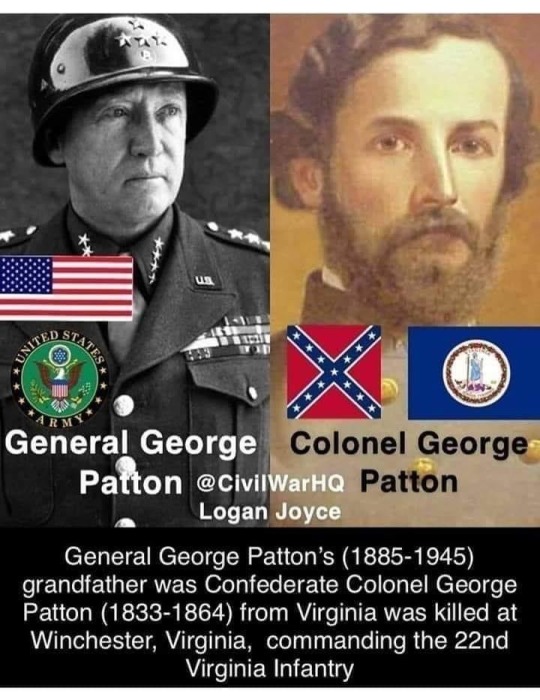

#general patton#theodore roosevelt#southerners#civil war#confederate#states rights#history#robert e lee#gravestones#confederacy#georgia#alabama#rebel#reconciliation#reconstruction#virginia
27 notes
·
View notes
Text

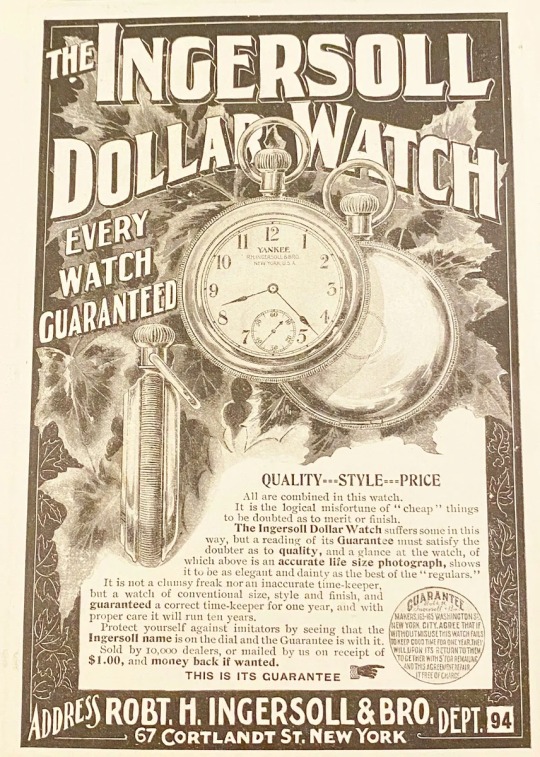
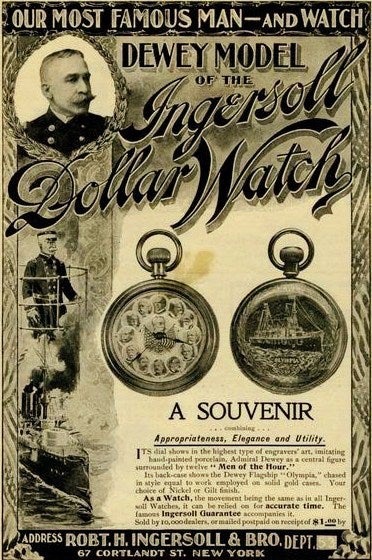


🇺🇲 In 1892 Robert Hawley and Charles Henry Ingersoll laid the foundation for The Ingersoll Watch Company. Born out of a humble mail order business in New York City in 1882, the company initially dealt in low-cost items like rubber stamps. However, their journey was destined for greater horizons.
⏱️ In 1896, Ingersoll revolutionized the watch industry by introducing the first-ever dollar watch – the "Yankee." Priced at a mere $1, it became an instant sensation, marking a significant milestone as the most affordable timepiece of its time. By 1899, an astonishing 8,000 watches were churned out daily, fueling the brand's exponential growth.
📊 Вy 1910, Ingersoll had become a household name, with over 10,000 dealers worldwide carrying their iconic timepieces. The dollar watch became synonymous with accessibility, democratizing timekeeping for people from all walks of life.
💰 Ingersoll's commitment to affordability and quality resonated with millions, with nearly 40 million dollar watches sold within two decades. Their impact was so profound that even president Theodore Roosevelt, during his African expedition, was recognized as "the man from the country where Ingersoll was produced."
💯 Ingersoll's legacy transcended mere timepieces; it became a cultural phenomenon. Their famous tagline, "The watch that made the dollar famous!" echoed across generations, cementing their place in horological history.
#TimeTrek#watch#clock#The Ingersoll Watch Company#ingersoll#yankee#dollar watch#retro#retro aesthetic#vintage#theodore roosevelt#president#brands#company#business#history#Robert Hawley#Charles Henry Ingersoll#new york#virginia#time#early 1900s#1890s#legendary#old watches#old technology#historical#made in usa#american watches#made in america
6 notes
·
View notes
Text

@frxncaise said; “ Please, just stay away from me. Stay away! ” (robert todd lincoln)
╰► SOURCE: Disney’s Frozen Franchise

ROBERT INSTINCTIVELY RAISED HIS hands in a defensive and apologetic gesture, taking a step backwards to move away from the HYPERVENTILATING woman.

“Whoa there!” Robert exclaimed breathlessly, fighting to steady his racing heart whilst he spoke. “It’s okay — I don’t want to hurt you. It’s just …” He took a deep, shaky breath. “…it’s just … uh … how did you get in here?”

#mayhaps a time travel verse with ange from our universe where she’s teddy roosevelt’s adopted daughter#getting thrown back into robert’s era during the war?#that might be tasty….#╭ ⁞ ❏. askbox replies.#╭ ⁞ ❏. narrations / robert todd lincoln.#frxncaise
4 notes
·
View notes
Text
Robert Oppenheimer on the death of Franklin Roosevelt.
Richard Rhodes The Making of the Atomic Bomb.
5 notes
·
View notes